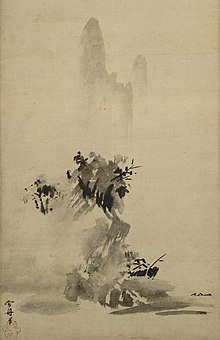Sesshū Tōyō
Sesshū Tōyō ( Japanese 雪 舟 等 楊 , Sesshū Tōyō ; * 1420 in Akahama, Bitchū Province (today: Sōja , Okayama Prefecture ); † August 26, 1506, probably in Yamaguchi ) was a Zen monk and the most important Japanese painter of the Muromachi Time ( 15th century ). His stage name ( gō ) is Sesshū , while Tōyō is his actual name ( imina ).
Life
Sesshū was born in 1420 in Bitchū Province, today's Okayama Prefecture. At the age of eleven he entered the Zen temple Hōfuku-ji in 1431 as a novice. At the age of 20 he was transferred as a monk to the Shōkoku-ji temple in Kyoto. But he left the temple, possibly staying in Kamakura and in 1464, at the request of the Ouchi family, moved on to Yamaguchi to the Unokoku-ji temple. The city had good relations with China at the time , so that he was able to travel to Beijing from there in 1468 and study at the imperial painting academy for several months. Later he was commissioned to decorate an official building in the city with wall paintings. He left China in 1469, returned to Yamaguchi and set up a studio in Bungo Province (today: Ōita Prefecture ) in 1476 , which he moved to Yamaguchi in 1486, where he probably died in 1506. None of his students could make a name for themselves.
Artistic creation

Nothing is known about his painting in China before years. His well-known works, such as the autumn landscape and the winter landscape , the date of which is not known, reveal that Sesshū Tōyō was strongly attached to Chinese ink painting, but developed creatively. He mixed Chinese with traditional Japanese painting and created his own form of painting with his deep, deserted ink landscapes, which is characterized by strong contrasts, skillful washes and economical, expressive and angular brushstrokes.
The "Long Landscape Scroll " ( Shikisansui ) is said to be his greatest masterpiece . This work, created in 1486, is 40 centimeters high and 15.85 meters long. Chinese landscapes are depicted in the change of the seasons, whereby Sesshu's full artistry can be admired, as he varied his brushwork, for example, but also his compositions. But it is also known that he worked in the Haboku style or Yamato-e style. It is believed that his last work is the picture Ama no Hashidate , which must have been made around the year 1501. In doing so, Sesshū has striven unusually for a realistic representation of the nature of Japan.
In addition to Sesshū, the Muromachi period also has other important artists. Contemporary painters were Josetsu , Shūbun and Sōtan . In contrast to these Sesshū was not his life in the service of Shoguns been and lived relatively independent in the province. His pictures are said to have been valued by both the citizens and the nobles. In addition, unlike his contemporaries, he created his works independently of poems as an independent painting. He should have been the founder of independent painting in Japan.
exhibition
- 2006: The Trip to Sesshu / Sesshū e no Tabi ( 雪 舟 へ の 旅 ), Yamaguchi Prefecture Art Museum
Others
Sesshū is involved in the five-part fantasy novel The Clan of Otori by Lian Hearn and is mentioned as an excellent artist. Lian Hearn describes Sesshu Tōyō as a unique artist in the foreword of the first book.
literature
- Elise Grilli: Sesshu Toyo . Ed .: Tanio Nakamura (= Kodansha Library of Japanese Art . Vol. 10). 3. Edition. Charles E. Tuttle, Rutland, Tokyo 1960 (English).
Web links
- Works by Sesshū Tōyō at Zeno.org .
Individual evidence
- ↑ The small encyclopedia , Encyclios-Verlag, Zurich, 1950, volume 2, page 601
- ^ The Trip to Sesshu Exhibition. (No longer available online.) Nippon Design Center, archived from the original on October 19, 2008 ; accessed on May 13, 2011 . Info: The archive link was inserted automatically and has not yet been checked. Please check the original and archive link according to the instructions and then remove this notice.
| personal data | |
|---|---|
| SURNAME | Sesshū Tōyō |
| ALTERNATIVE NAMES | 雪 舟 等 楊 (Japanese) |
| BRIEF DESCRIPTION | Japanese Zen monk and painter |
| DATE OF BIRTH | 1420 |
| PLACE OF BIRTH | Akahama, Bitchū Province (today: Sōja , Okayama Prefecture) |
| DATE OF DEATH | August 26, 1506 |
| Place of death | unsure: Yamaguchi |
